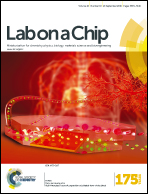Enzyme catalysis–electrophoresis titration for multiplex enzymatic assay via moving reaction boundary chip†
Abstract
In this work, we developed the concept of enzyme catalysis–electrophoresis titration (EC-ET) under ideal conditions, the theory of EC-ET for multiplex enzymatic assay (MEA), and a related method based on a moving reaction boundary (MRB) chip with a collateral channel and cell phone imaging. As a proof of principle, the model enzymes horseradish peroxidase (HRP), laccase and myeloperoxidase (MPO) were chosen for the tests of the EC-ET model. The experiments revealed that the EC-ET model could be achieved via coupling EC with ET within a MRB chip; particularly the MEA analyses of catalysis rate, maximum rate, activity, Km and Kcat could be conducted via a single run of the EC-ET chip, systemically demonstrating the validity of the EC-ET theory. Moreover, the developed method had these merits: (i) two orders of magnitude higher sensitivity than a fluorescence microplate reader, (ii) simplicity and low cost, and (iii) fairly rapid (30 min incubation, 20 s imaging) analysis, fair stability (<5.0% RSD) and accuracy, thus validating the EC-ET method. Finally, the developed EC-ET method was used for the clinical assay of MPO activity in blood samples; the values of MPO activity detected via the EC-ET chip were in agreement with those obtained by a traditional fluorescence microplate reader, indicating the applicability of the EC-ET method. The work opens a window for the development of enzymatic research, enzyme assay, immunoassay, and point-of-care testing as well as titration, one of the oldest methods of analysis, based on a simple chip.


 Please wait while we load your content...
Please wait while we load your content...